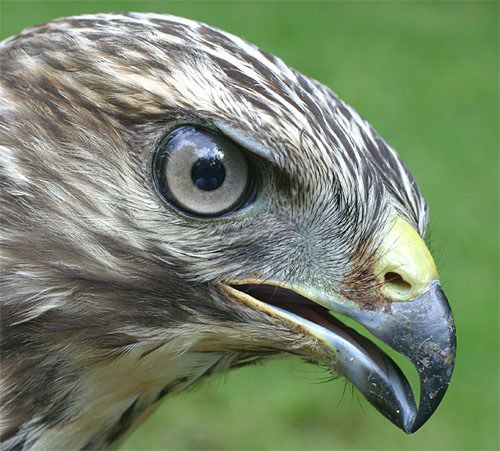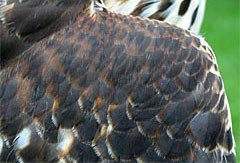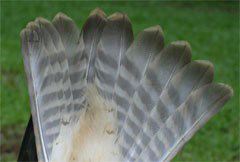|
|
|||
|
|
|||
(Back to Preceding Week; on to Next Week)
|
RED-SHOULDERED RE-VISITED Although we've written about Red-shouldered Hawks before, an event on the morning of 7 August gave us cause to revisit this raptorial species. Shortly after breakfast we were sitting at our computer desk in the old farmhouse at Hilton Pond Center, observing a couple of young Eastern Chipmunks chase each other around a Shagbark Hickory that shades the office windows. Something else also must have been watching, for suddenly we saw coming at us the head-on profile of what could only be a bird of prey. On the other side of us and the chipmunks, however, stood a seven- foot-tall mist net we had opened at dawn to catch hummingbirds, and the fast-moving raptor was making a bee-line for it--undoubtedly with its eye on lunch rather than the fine mesh of a net. Whump! The hawk hit the net with noticeable force and might have bounced out, but the small hummingbird mesh caught on its talons and the hefty bird fell into a loose bag of net adequate to hold it. We quickly ran outside--it's not uncommon for a large bird to release itself from a small-mesh net--to see if we could extricate the bird before it got away. 
All text & photos © Hilton Pond Center One does not casually remove a Red-shouldered Hawk from a net or trap. Its raptorial feet are powerful and its three-quarter-inch talons are stiletto-like, easily capable of penetrating deep into the hand or finger of a careless bird bander. A netted hawk often lies there calmly with its toes widespread and talons at the ready, but during removal from a net the bird typically clenches up (below right)--preferably NOT around any part of the bander's anatomy. We carefully grabbed the snared hawk's lower legs--the scaly, featherless part known as the "tibiotarsus"--and then went to work uncurling the toes enough to remove the netting. Despite the strength of its foot, the bird came out fairly easily, and as we stood beside the net with a one-handed grip on the bird's upper legs it began to flap with both wings. Had it been a Roc instead of a Red-shouldered Hawk, it would have lifted us skyward and we would have been flying over Hilton Pond like Sinbad--or like some soon-to-be-eaten dead chipmunk. The hawk calmed down almost immediately, so we carried it inside for measurements and banding. Its wing chord was only 295mm, quite smallish for a Red-shouldered Hawk and an indication it was likely a male. In many raptor species, sexes look the same but the female is 25-30% larger--rather unusual in the bird world. Unfortunately, overlap of sizes in red-shoulders makes the wing chord an unreliable indicator for a bird's sex.
 .. .. Red-shouldereds are widely distributed across the eastern U.S. In the Carolina Piedmont many are year-round residents, but breeding birds from New England and the Great Lakes States usually fly south for the winter. At Hawk Mountain Sanctuary in eastern Pennsylvania, it's not unusual to see Red-shouldered Hawks streaming past North Lookout in mid-October--just before the cold days of autumn arrive. Wherever they range, red-shouldereds can avoid competing with the larger Red-tailed Hawk by working moist woodlands and other riparian sites rather than vast open fields. Since 1982 we've caught and banded six Red-shouldered Hawks at Hilton Pond Center: two adults with dark yellow eyes, two second-year birds with pale yellow irises, and two young birds-of-the-year with gray eyes. Comments or questions about this week's installment? NOTE: Be sure to scroll down for an account of all birds banded or recaptured during the week, as well as some other interesting nature notes. "This Week at Hilton Pond" is written & photographed You may wish to consult our Index of all nature topics covered since February 2000. You can also use the on-line Search Engine at the bottom of this page. For a free, non-fattening, on-line subscription to "This Week at Hilton Pond," just send us an E-mail with Subscribe in the subject line. Please be sure to configure your spam filter to accept E-mails from hiltonpond.org. |
|
Make direct donations on-line through
Network for Good: |
|
|
LIKE TO SHOP ON-LINE?
Donate a portion of your purchase price from 500+ top on-line stores via iGive: |
|
|
Use your PayPal account
to make direct donations: |
|
|
contact Bill Hilton Jr. |
|
|
|
SPECIES BANDED THIS WEEK: * = New species for 2003 WEEKLY BANDING TOTAL 5 species 24 individuals
YEARLY BANDING TOTAL (2003) 47 species 752 individuals
BANDING GRAND TOTAL (since 28 June 1982) 123 species 42,866 individuals
NOTABLE RECAPTURES THIS WEEK (with original banding date, sex, and current age) NONE |
OTHER SIGHTINGS OF INTEREST
VAGRANT HUMMINGBIRDS --An adult male Rufous Hummingbird was videotaped visiting a feeder in the Dutch Fork area just north of Columbia SC on the weekend of 1-3 Aug. The vagrant was not seen on 4 Aug, but we visited the site for an attempted banding on 5 Aug; the bird apparently has moved on. Photos are in the Gallery for Operation RubyThroat: The Hummingbird Project. This may be the earliest summer sighting of a vagrant adult rufous for the state, beating by almost a week another male banded by us at Sharon SC on 6 Aug 1994. |
(Back to Preceding Week; on to Next Week)
|
Up to Top of Page Current Weather Conditions at Hilton Pond Center |
 post questions for The Piedmont Naturalist |
Join the |
Search Engine for |
|
|